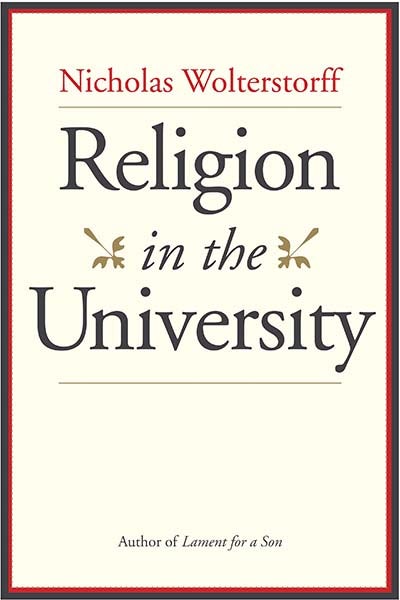Reviewed by Arina Zaytseva, Department of Religion
In his 2019 book Religion in the University, Nicholas Wolterstorff, professor emeritus of philosophical theology at Yale University, provides a soaring overview of the changes that “the so-called secular universities within pluralist democratic societies” based predominantly in North America have undergone in the last fifty years. Wolterstorff is particularly interested in the status of religious belief at the universities––he asks whether it is “permissible for the scholar who is religious to allow her religion to shape how she engages in the practice of her discipline?” (4) Religion in the University provides a broad yet definitive answer to this question in four concise chapters.
Wolterstorff argues that the “traditional” outlook on goals and methods of academic learning is best described by the famous German sociologist Max Weber. In his 1917 lecture Science as a Vocation, Weber states that scientific activity aims to state “objective” facts about the world we live in. These facts can be arrived at with the help of three “belief-forming” faculties, such as perception, introspection, and rational intuition. (20) Objective facts can be understood by others and are open to criticism. Religious beliefs, however, are not derived from either of the abovementioned faculties and appear to be inaccessible for larger audiences as well as immunized against critique. (61) In Weber’s worldview, religion is a private matter as it deals with subjective value judgements. It should be practiced either at home or at houses of worship, but it has no place at a university.
Wolterstorff argues that many critics implicitly agree with Weber even today. However, “traditional” views on academic learning have been significantly challenged over the past few decades. For example, Thomas Kuhn argued that scientific revolutions don’t happen with the influx of new evidence (or facts). It happens when the evidence is viewed through the lens of a new theory. (36) Later, Hans-Georg Gadamer stated that that “facts” cannot exist without interpretation––researchers always assign some value to them. Individuals interpret facts from their prior beliefs and expectations, or “prejudgments.” (59) Moreover, according to an Enlightenment philosopher Thomas Reid, human beings, including researchers, rely on testimonies of others to form their beliefs. (54) These ideas challenged Weber’s claim that the facts about the world can be free of our interpretation.
The universities themselves have changed over the years. They have welcomed researchers of varied backgrounds, e.g., women, people of color, LGBTQIA+ researchers, etc., who have access to “certain dimensions of reality” that are hidden from others. This led to multiplication of research and instruction “shaped by the interests, values, convictions, and sensibilities” characteristic of various “character-identities.” (50)
Considering this, Wolterstorff argues that religious “character-identities” have a place in the Academy. First, he states that religious beliefs are usually held on the basis of experience or testimony and not one the basis of arguments––just like many other beliefs that are considered “rational.” (105) This leads us to conclude “that religious people do not suffer from some generalized deficiency of rationality just by virtue of holding religious beliefs.” (113) Moreover, in an “alternative” modern university, individuals don’t just offer their interpretations and theories but listen to the reasons of others. (129) This includes religious voices as they provide certain comprehensive orientations toward learning and interpretation of facts.
Because of its scope Religion in the University glosses over many issues that come into picture when one considers the limitations of religious belief in the Academy. For example, Wolterstorff states that the open academic does warn us against welcoming “fundamentalists” (146). However, who decides which beliefs are fundamentalist? What are the criteria? Do religious beliefs have to be open to criticism to be welcome in the Academy? Moreover, were there any other precedents of “pluralist” universities in world history?
Despite these questions, Religion in the University is a compelling read that urges its audience to rethink their presuppositions about what constitutes as academic learning and religious belief. Nicholas Wolterstorff provides more than a simple assessment of the place of religion in the Academy, he reaffirms the values of dignity and respect in academic setting and highlights the importance of respectful dialogue between pluralist voices.

